The Influence of Family and Lifestyle on Consumer Behavior
VerifiedAdded on 2023/06/08
|7
|2697
|359
AI Summary
This article discusses how family and lifestyle influence consumer behavior and how businesses can develop a market plan to meet the needs and wants of their customers. It includes a customer journey map and analysis of consumer behavior concepts such as motivation, attitude, and emotion. Subject: Marketing, Course Code: MKT101, College/University: Not mentioned
Contribute Materials
Your contribution can guide someone’s learning journey. Share your
documents today.
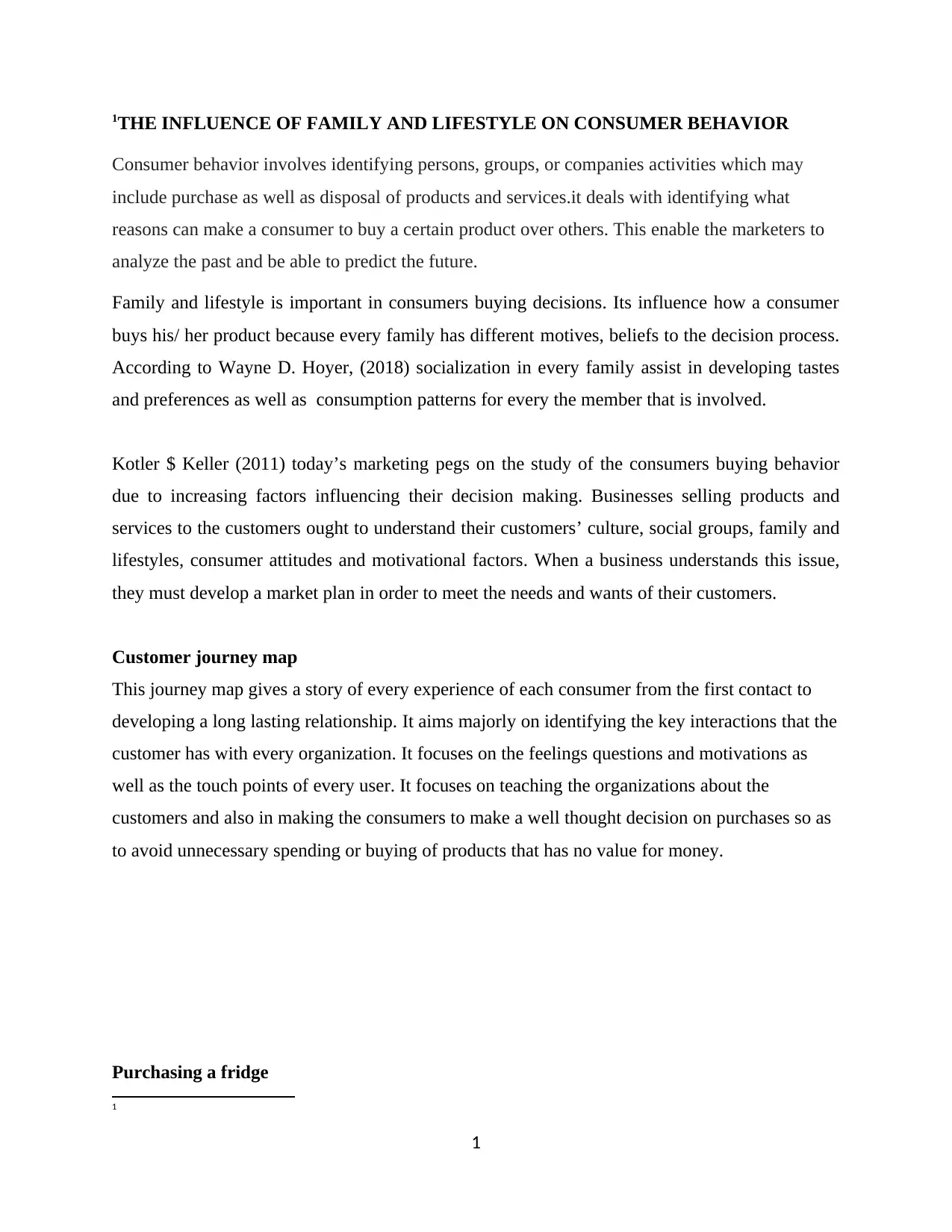
1THE INFLUENCE OF FAMILY AND LIFESTYLE ON CONSUMER BEHAVIOR
Consumer behavior involves identifying persons, groups, or companies activities which may
include purchase as well as disposal of products and services.it deals with identifying what
reasons can make a consumer to buy a certain product over others. This enable the marketers to
analyze the past and be able to predict the future.
Family and lifestyle is important in consumers buying decisions. Its influence how a consumer
buys his/ her product because every family has different motives, beliefs to the decision process.
According to Wayne D. Hoyer, (2018) socialization in every family assist in developing tastes
and preferences as well as consumption patterns for every the member that is involved.
Kotler $ Keller (2011) today’s marketing pegs on the study of the consumers buying behavior
due to increasing factors influencing their decision making. Businesses selling products and
services to the customers ought to understand their customers’ culture, social groups, family and
lifestyles, consumer attitudes and motivational factors. When a business understands this issue,
they must develop a market plan in order to meet the needs and wants of their customers.
Customer journey map
This journey map gives a story of every experience of each consumer from the first contact to
developing a long lasting relationship. It aims majorly on identifying the key interactions that the
customer has with every organization. It focuses on the feelings questions and motivations as
well as the touch points of every user. It focuses on teaching the organizations about the
customers and also in making the consumers to make a well thought decision on purchases so as
to avoid unnecessary spending or buying of products that has no value for money.
Purchasing a fridge
1
1
Consumer behavior involves identifying persons, groups, or companies activities which may
include purchase as well as disposal of products and services.it deals with identifying what
reasons can make a consumer to buy a certain product over others. This enable the marketers to
analyze the past and be able to predict the future.
Family and lifestyle is important in consumers buying decisions. Its influence how a consumer
buys his/ her product because every family has different motives, beliefs to the decision process.
According to Wayne D. Hoyer, (2018) socialization in every family assist in developing tastes
and preferences as well as consumption patterns for every the member that is involved.
Kotler $ Keller (2011) today’s marketing pegs on the study of the consumers buying behavior
due to increasing factors influencing their decision making. Businesses selling products and
services to the customers ought to understand their customers’ culture, social groups, family and
lifestyles, consumer attitudes and motivational factors. When a business understands this issue,
they must develop a market plan in order to meet the needs and wants of their customers.
Customer journey map
This journey map gives a story of every experience of each consumer from the first contact to
developing a long lasting relationship. It aims majorly on identifying the key interactions that the
customer has with every organization. It focuses on the feelings questions and motivations as
well as the touch points of every user. It focuses on teaching the organizations about the
customers and also in making the consumers to make a well thought decision on purchases so as
to avoid unnecessary spending or buying of products that has no value for money.
Purchasing a fridge
1
1
Secure Best Marks with AI Grader
Need help grading? Try our AI Grader for instant feedback on your assignments.
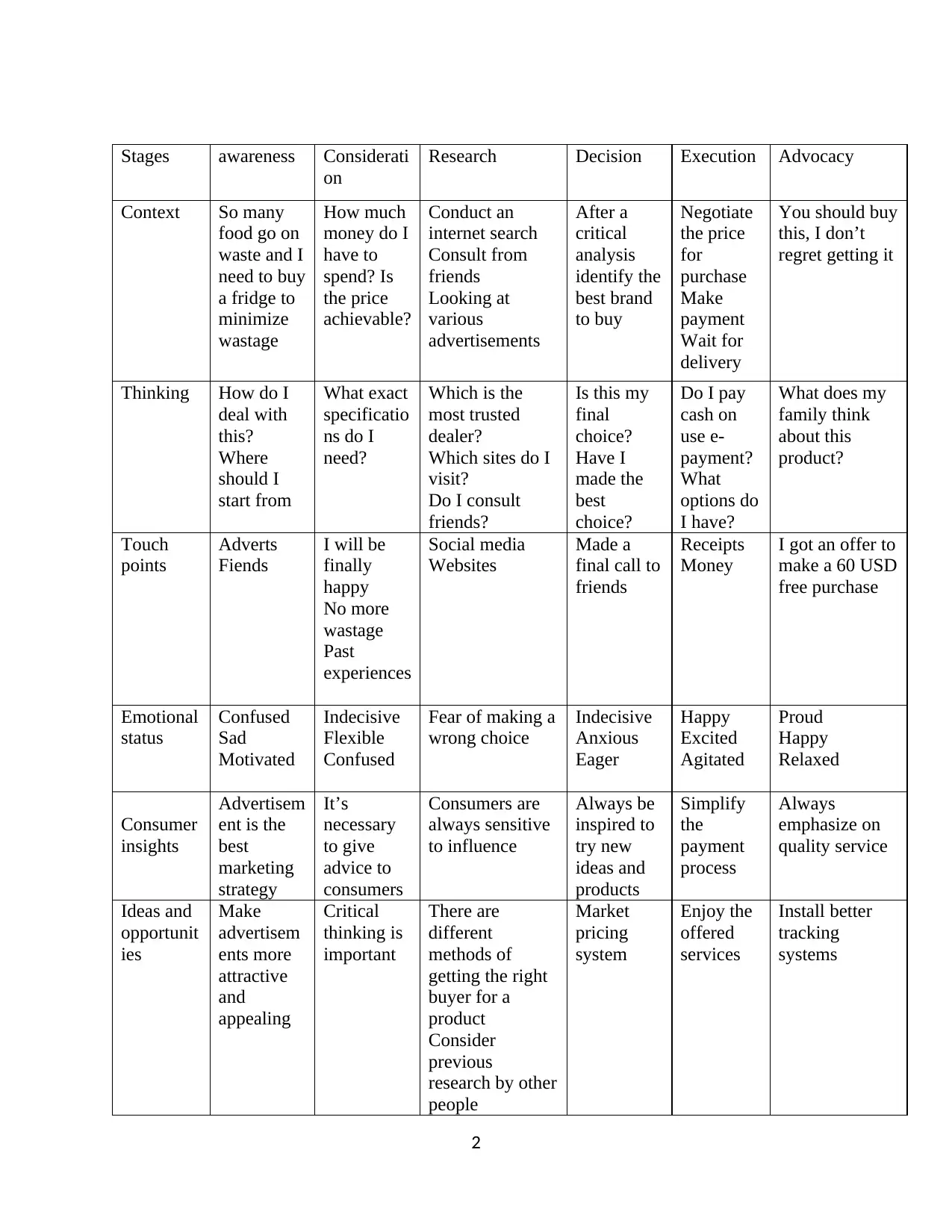
Stages awareness Considerati
on
Research Decision Execution Advocacy
Context So many
food go on
waste and I
need to buy
a fridge to
minimize
wastage
How much
money do I
have to
spend? Is
the price
achievable?
Conduct an
internet search
Consult from
friends
Looking at
various
advertisements
After a
critical
analysis
identify the
best brand
to buy
Negotiate
the price
for
purchase
Make
payment
Wait for
delivery
You should buy
this, I don’t
regret getting it
Thinking How do I
deal with
this?
Where
should I
start from
What exact
specificatio
ns do I
need?
Which is the
most trusted
dealer?
Which sites do I
visit?
Do I consult
friends?
Is this my
final
choice?
Have I
made the
best
choice?
Do I pay
cash on
use e-
payment?
What
options do
I have?
What does my
family think
about this
product?
Touch
points
Adverts
Fiends
I will be
finally
happy
No more
wastage
Past
experiences
Social media
Websites
Made a
final call to
friends
Receipts
Money
I got an offer to
make a 60 USD
free purchase
Emotional
status
Confused
Sad
Motivated
Indecisive
Flexible
Confused
Fear of making a
wrong choice
Indecisive
Anxious
Eager
Happy
Excited
Agitated
Proud
Happy
Relaxed
Consumer
insights
Advertisem
ent is the
best
marketing
strategy
It’s
necessary
to give
advice to
consumers
Consumers are
always sensitive
to influence
Always be
inspired to
try new
ideas and
products
Simplify
the
payment
process
Always
emphasize on
quality service
Ideas and
opportunit
ies
Make
advertisem
ents more
attractive
and
appealing
Critical
thinking is
important
There are
different
methods of
getting the right
buyer for a
product
Consider
previous
research by other
people
Market
pricing
system
Enjoy the
offered
services
Install better
tracking
systems
2
on
Research Decision Execution Advocacy
Context So many
food go on
waste and I
need to buy
a fridge to
minimize
wastage
How much
money do I
have to
spend? Is
the price
achievable?
Conduct an
internet search
Consult from
friends
Looking at
various
advertisements
After a
critical
analysis
identify the
best brand
to buy
Negotiate
the price
for
purchase
Make
payment
Wait for
delivery
You should buy
this, I don’t
regret getting it
Thinking How do I
deal with
this?
Where
should I
start from
What exact
specificatio
ns do I
need?
Which is the
most trusted
dealer?
Which sites do I
visit?
Do I consult
friends?
Is this my
final
choice?
Have I
made the
best
choice?
Do I pay
cash on
use e-
payment?
What
options do
I have?
What does my
family think
about this
product?
Touch
points
Adverts
Fiends
I will be
finally
happy
No more
wastage
Past
experiences
Social media
Websites
Made a
final call to
friends
Receipts
Money
I got an offer to
make a 60 USD
free purchase
Emotional
status
Confused
Sad
Motivated
Indecisive
Flexible
Confused
Fear of making a
wrong choice
Indecisive
Anxious
Eager
Happy
Excited
Agitated
Proud
Happy
Relaxed
Consumer
insights
Advertisem
ent is the
best
marketing
strategy
It’s
necessary
to give
advice to
consumers
Consumers are
always sensitive
to influence
Always be
inspired to
try new
ideas and
products
Simplify
the
payment
process
Always
emphasize on
quality service
Ideas and
opportunit
ies
Make
advertisem
ents more
attractive
and
appealing
Critical
thinking is
important
There are
different
methods of
getting the right
buyer for a
product
Consider
previous
research by other
people
Market
pricing
system
Enjoy the
offered
services
Install better
tracking
systems
2
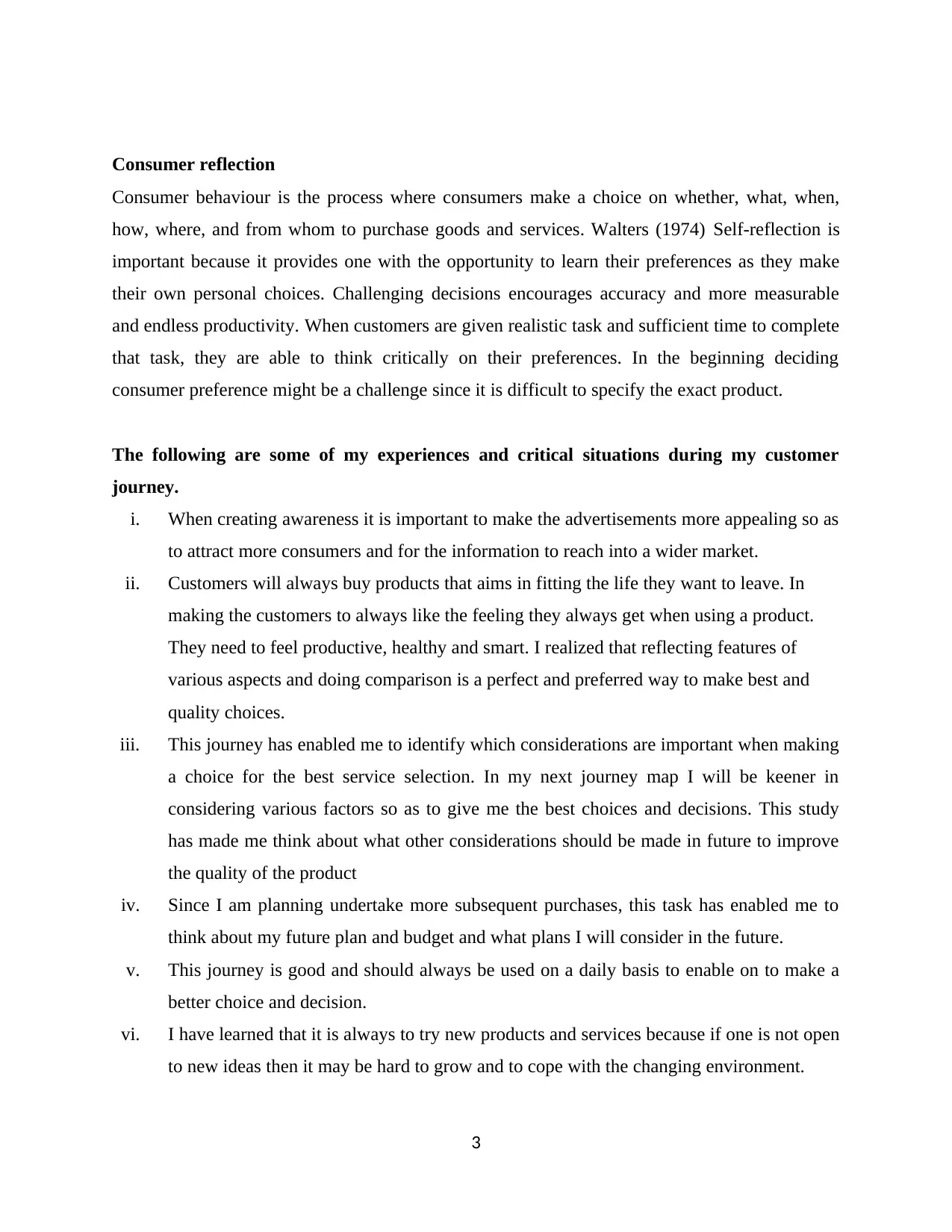
Consumer reflection
Consumer behaviour is the process where consumers make a choice on whether, what, when,
how, where, and from whom to purchase goods and services. Walters (1974) Self-reflection is
important because it provides one with the opportunity to learn their preferences as they make
their own personal choices. Challenging decisions encourages accuracy and more measurable
and endless productivity. When customers are given realistic task and sufficient time to complete
that task, they are able to think critically on their preferences. In the beginning deciding
consumer preference might be a challenge since it is difficult to specify the exact product.
The following are some of my experiences and critical situations during my customer
journey.
i. When creating awareness it is important to make the advertisements more appealing so as
to attract more consumers and for the information to reach into a wider market.
ii. Customers will always buy products that aims in fitting the life they want to leave. In
making the customers to always like the feeling they always get when using a product.
They need to feel productive, healthy and smart. I realized that reflecting features of
various aspects and doing comparison is a perfect and preferred way to make best and
quality choices.
iii. This journey has enabled me to identify which considerations are important when making
a choice for the best service selection. In my next journey map I will be keener in
considering various factors so as to give me the best choices and decisions. This study
has made me think about what other considerations should be made in future to improve
the quality of the product
iv. Since I am planning undertake more subsequent purchases, this task has enabled me to
think about my future plan and budget and what plans I will consider in the future.
v. This journey is good and should always be used on a daily basis to enable on to make a
better choice and decision.
vi. I have learned that it is always to try new products and services because if one is not open
to new ideas then it may be hard to grow and to cope with the changing environment.
3
Consumer behaviour is the process where consumers make a choice on whether, what, when,
how, where, and from whom to purchase goods and services. Walters (1974) Self-reflection is
important because it provides one with the opportunity to learn their preferences as they make
their own personal choices. Challenging decisions encourages accuracy and more measurable
and endless productivity. When customers are given realistic task and sufficient time to complete
that task, they are able to think critically on their preferences. In the beginning deciding
consumer preference might be a challenge since it is difficult to specify the exact product.
The following are some of my experiences and critical situations during my customer
journey.
i. When creating awareness it is important to make the advertisements more appealing so as
to attract more consumers and for the information to reach into a wider market.
ii. Customers will always buy products that aims in fitting the life they want to leave. In
making the customers to always like the feeling they always get when using a product.
They need to feel productive, healthy and smart. I realized that reflecting features of
various aspects and doing comparison is a perfect and preferred way to make best and
quality choices.
iii. This journey has enabled me to identify which considerations are important when making
a choice for the best service selection. In my next journey map I will be keener in
considering various factors so as to give me the best choices and decisions. This study
has made me think about what other considerations should be made in future to improve
the quality of the product
iv. Since I am planning undertake more subsequent purchases, this task has enabled me to
think about my future plan and budget and what plans I will consider in the future.
v. This journey is good and should always be used on a daily basis to enable on to make a
better choice and decision.
vi. I have learned that it is always to try new products and services because if one is not open
to new ideas then it may be hard to grow and to cope with the changing environment.
3
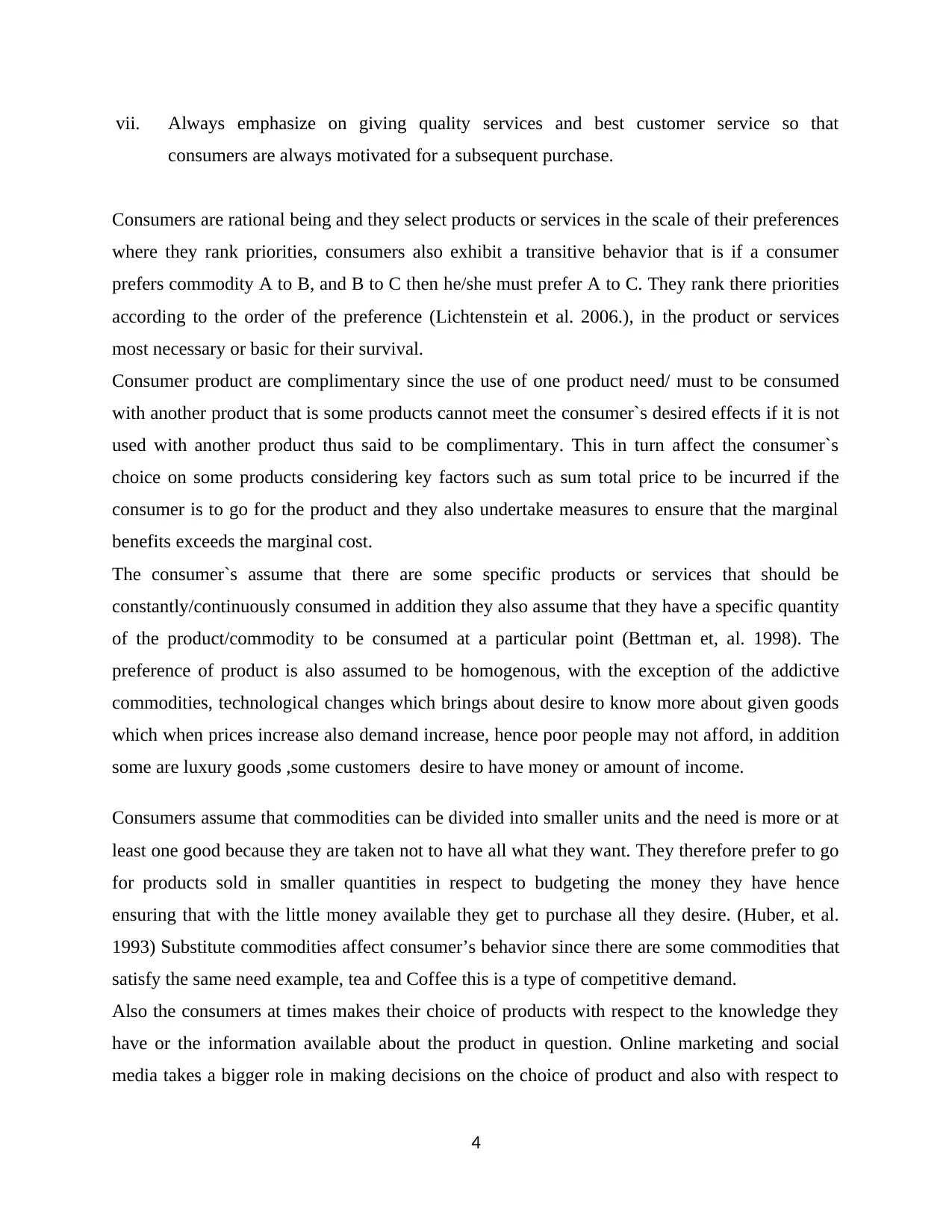
vii. Always emphasize on giving quality services and best customer service so that
consumers are always motivated for a subsequent purchase.
Consumers are rational being and they select products or services in the scale of their preferences
where they rank priorities, consumers also exhibit a transitive behavior that is if a consumer
prefers commodity A to B, and B to C then he/she must prefer A to C. They rank there priorities
according to the order of the preference (Lichtenstein et al. 2006.), in the product or services
most necessary or basic for their survival.
Consumer product are complimentary since the use of one product need/ must to be consumed
with another product that is some products cannot meet the consumer`s desired effects if it is not
used with another product thus said to be complimentary. This in turn affect the consumer`s
choice on some products considering key factors such as sum total price to be incurred if the
consumer is to go for the product and they also undertake measures to ensure that the marginal
benefits exceeds the marginal cost.
The consumer`s assume that there are some specific products or services that should be
constantly/continuously consumed in addition they also assume that they have a specific quantity
of the product/commodity to be consumed at a particular point (Bettman et, al. 1998). The
preference of product is also assumed to be homogenous, with the exception of the addictive
commodities, technological changes which brings about desire to know more about given goods
which when prices increase also demand increase, hence poor people may not afford, in addition
some are luxury goods ,some customers desire to have money or amount of income.
Consumers assume that commodities can be divided into smaller units and the need is more or at
least one good because they are taken not to have all what they want. They therefore prefer to go
for products sold in smaller quantities in respect to budgeting the money they have hence
ensuring that with the little money available they get to purchase all they desire. (Huber, et al.
1993) Substitute commodities affect consumer’s behavior since there are some commodities that
satisfy the same need example, tea and Coffee this is a type of competitive demand.
Also the consumers at times makes their choice of products with respect to the knowledge they
have or the information available about the product in question. Online marketing and social
media takes a bigger role in making decisions on the choice of product and also with respect to
4
consumers are always motivated for a subsequent purchase.
Consumers are rational being and they select products or services in the scale of their preferences
where they rank priorities, consumers also exhibit a transitive behavior that is if a consumer
prefers commodity A to B, and B to C then he/she must prefer A to C. They rank there priorities
according to the order of the preference (Lichtenstein et al. 2006.), in the product or services
most necessary or basic for their survival.
Consumer product are complimentary since the use of one product need/ must to be consumed
with another product that is some products cannot meet the consumer`s desired effects if it is not
used with another product thus said to be complimentary. This in turn affect the consumer`s
choice on some products considering key factors such as sum total price to be incurred if the
consumer is to go for the product and they also undertake measures to ensure that the marginal
benefits exceeds the marginal cost.
The consumer`s assume that there are some specific products or services that should be
constantly/continuously consumed in addition they also assume that they have a specific quantity
of the product/commodity to be consumed at a particular point (Bettman et, al. 1998). The
preference of product is also assumed to be homogenous, with the exception of the addictive
commodities, technological changes which brings about desire to know more about given goods
which when prices increase also demand increase, hence poor people may not afford, in addition
some are luxury goods ,some customers desire to have money or amount of income.
Consumers assume that commodities can be divided into smaller units and the need is more or at
least one good because they are taken not to have all what they want. They therefore prefer to go
for products sold in smaller quantities in respect to budgeting the money they have hence
ensuring that with the little money available they get to purchase all they desire. (Huber, et al.
1993) Substitute commodities affect consumer’s behavior since there are some commodities that
satisfy the same need example, tea and Coffee this is a type of competitive demand.
Also the consumers at times makes their choice of products with respect to the knowledge they
have or the information available about the product in question. Online marketing and social
media takes a bigger role in making decisions on the choice of product and also with respect to
4
Secure Best Marks with AI Grader
Need help grading? Try our AI Grader for instant feedback on your assignments.
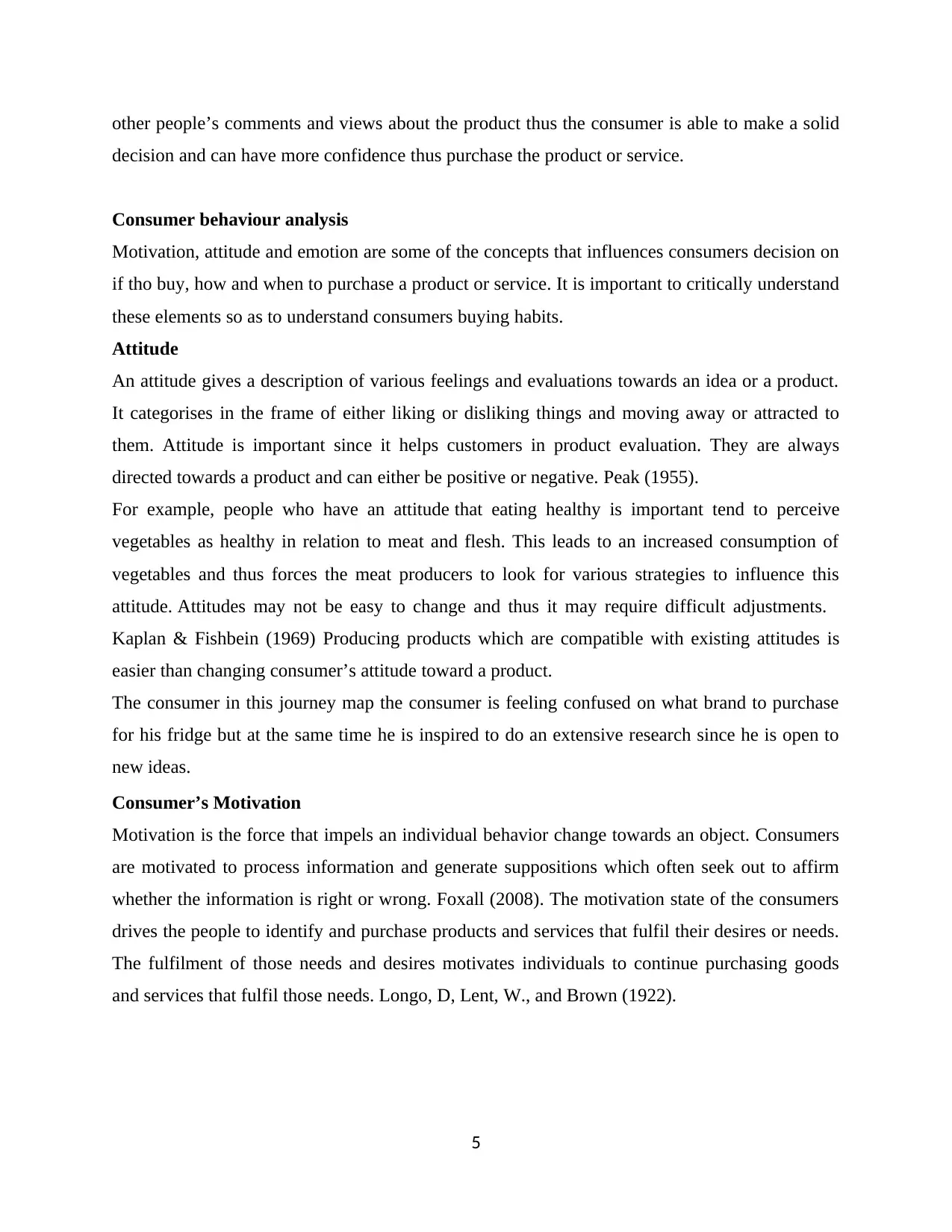
other people’s comments and views about the product thus the consumer is able to make a solid
decision and can have more confidence thus purchase the product or service.
Consumer behaviour analysis
Motivation, attitude and emotion are some of the concepts that influences consumers decision on
if tho buy, how and when to purchase a product or service. It is important to critically understand
these elements so as to understand consumers buying habits.
Attitude
An attitude gives a description of various feelings and evaluations towards an idea or a product.
It categorises in the frame of either liking or disliking things and moving away or attracted to
them. Attitude is important since it helps customers in product evaluation. They are always
directed towards a product and can either be positive or negative. Peak (1955).
For example, people who have an attitude that eating healthy is important tend to perceive
vegetables as healthy in relation to meat and flesh. This leads to an increased consumption of
vegetables and thus forces the meat producers to look for various strategies to influence this
attitude. Attitudes may not be easy to change and thus it may require difficult adjustments.
Kaplan & Fishbein (1969) Producing products which are compatible with existing attitudes is
easier than changing consumer’s attitude toward a product.
The consumer in this journey map the consumer is feeling confused on what brand to purchase
for his fridge but at the same time he is inspired to do an extensive research since he is open to
new ideas.
Consumer’s Motivation
Motivation is the force that impels an individual behavior change towards an object. Consumers
are motivated to process information and generate suppositions which often seek out to affirm
whether the information is right or wrong. Foxall (2008). The motivation state of the consumers
drives the people to identify and purchase products and services that fulfil their desires or needs.
The fulfilment of those needs and desires motivates individuals to continue purchasing goods
and services that fulfil those needs. Longo, D, Lent, W., and Brown (1922).
5
decision and can have more confidence thus purchase the product or service.
Consumer behaviour analysis
Motivation, attitude and emotion are some of the concepts that influences consumers decision on
if tho buy, how and when to purchase a product or service. It is important to critically understand
these elements so as to understand consumers buying habits.
Attitude
An attitude gives a description of various feelings and evaluations towards an idea or a product.
It categorises in the frame of either liking or disliking things and moving away or attracted to
them. Attitude is important since it helps customers in product evaluation. They are always
directed towards a product and can either be positive or negative. Peak (1955).
For example, people who have an attitude that eating healthy is important tend to perceive
vegetables as healthy in relation to meat and flesh. This leads to an increased consumption of
vegetables and thus forces the meat producers to look for various strategies to influence this
attitude. Attitudes may not be easy to change and thus it may require difficult adjustments.
Kaplan & Fishbein (1969) Producing products which are compatible with existing attitudes is
easier than changing consumer’s attitude toward a product.
The consumer in this journey map the consumer is feeling confused on what brand to purchase
for his fridge but at the same time he is inspired to do an extensive research since he is open to
new ideas.
Consumer’s Motivation
Motivation is the force that impels an individual behavior change towards an object. Consumers
are motivated to process information and generate suppositions which often seek out to affirm
whether the information is right or wrong. Foxall (2008). The motivation state of the consumers
drives the people to identify and purchase products and services that fulfil their desires or needs.
The fulfilment of those needs and desires motivates individuals to continue purchasing goods
and services that fulfil those needs. Longo, D, Lent, W., and Brown (1922).
5
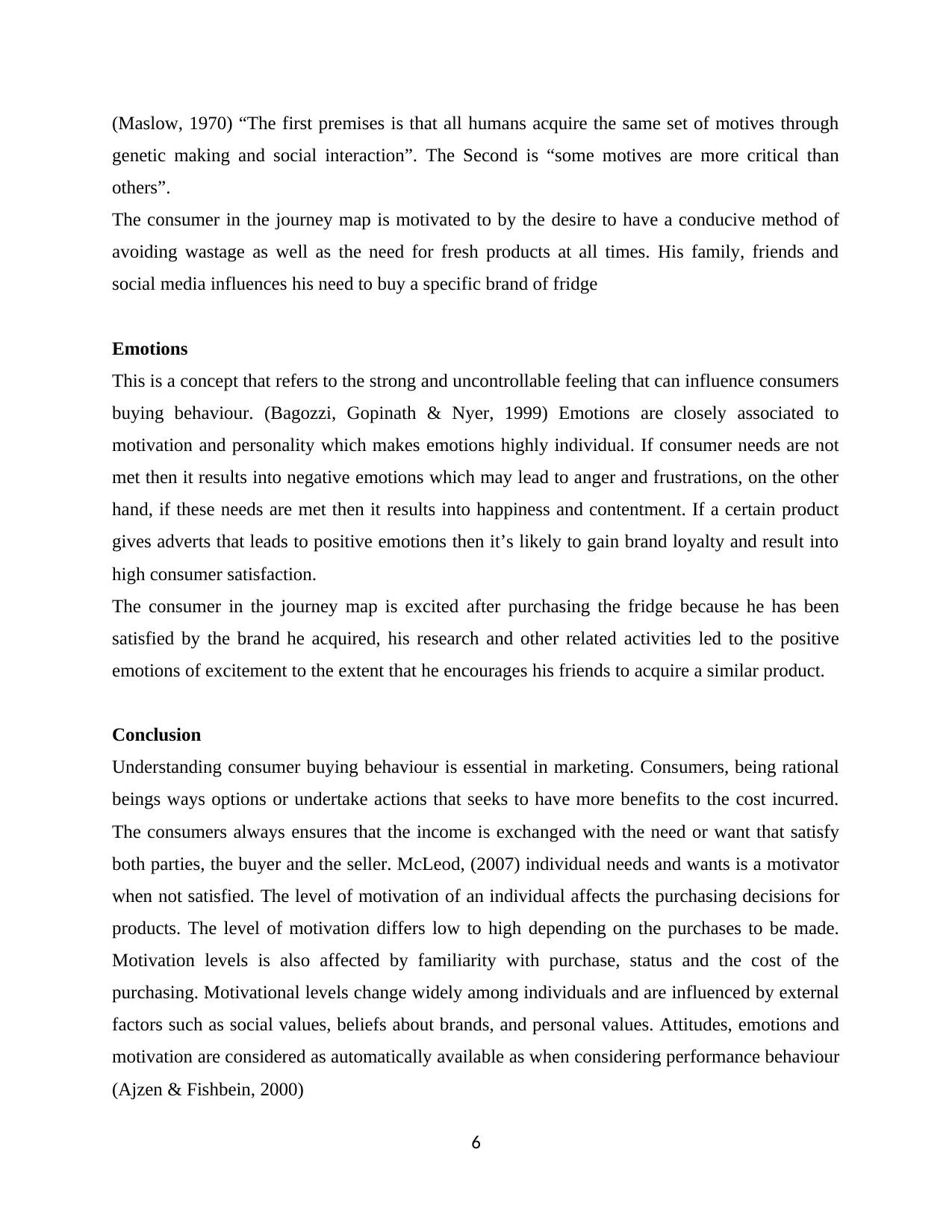
(Maslow, 1970) “The first premises is that all humans acquire the same set of motives through
genetic making and social interaction”. The Second is “some motives are more critical than
others”.
The consumer in the journey map is motivated to by the desire to have a conducive method of
avoiding wastage as well as the need for fresh products at all times. His family, friends and
social media influences his need to buy a specific brand of fridge
Emotions
This is a concept that refers to the strong and uncontrollable feeling that can influence consumers
buying behaviour. (Bagozzi, Gopinath & Nyer, 1999) Emotions are closely associated to
motivation and personality which makes emotions highly individual. If consumer needs are not
met then it results into negative emotions which may lead to anger and frustrations, on the other
hand, if these needs are met then it results into happiness and contentment. If a certain product
gives adverts that leads to positive emotions then it’s likely to gain brand loyalty and result into
high consumer satisfaction.
The consumer in the journey map is excited after purchasing the fridge because he has been
satisfied by the brand he acquired, his research and other related activities led to the positive
emotions of excitement to the extent that he encourages his friends to acquire a similar product.
Conclusion
Understanding consumer buying behaviour is essential in marketing. Consumers, being rational
beings ways options or undertake actions that seeks to have more benefits to the cost incurred.
The consumers always ensures that the income is exchanged with the need or want that satisfy
both parties, the buyer and the seller. McLeod, (2007) individual needs and wants is a motivator
when not satisfied. The level of motivation of an individual affects the purchasing decisions for
products. The level of motivation differs low to high depending on the purchases to be made.
Motivation levels is also affected by familiarity with purchase, status and the cost of the
purchasing. Motivational levels change widely among individuals and are influenced by external
factors such as social values, beliefs about brands, and personal values. Attitudes, emotions and
motivation are considered as automatically available as when considering performance behaviour
(Ajzen & Fishbein, 2000)
6
genetic making and social interaction”. The Second is “some motives are more critical than
others”.
The consumer in the journey map is motivated to by the desire to have a conducive method of
avoiding wastage as well as the need for fresh products at all times. His family, friends and
social media influences his need to buy a specific brand of fridge
Emotions
This is a concept that refers to the strong and uncontrollable feeling that can influence consumers
buying behaviour. (Bagozzi, Gopinath & Nyer, 1999) Emotions are closely associated to
motivation and personality which makes emotions highly individual. If consumer needs are not
met then it results into negative emotions which may lead to anger and frustrations, on the other
hand, if these needs are met then it results into happiness and contentment. If a certain product
gives adverts that leads to positive emotions then it’s likely to gain brand loyalty and result into
high consumer satisfaction.
The consumer in the journey map is excited after purchasing the fridge because he has been
satisfied by the brand he acquired, his research and other related activities led to the positive
emotions of excitement to the extent that he encourages his friends to acquire a similar product.
Conclusion
Understanding consumer buying behaviour is essential in marketing. Consumers, being rational
beings ways options or undertake actions that seeks to have more benefits to the cost incurred.
The consumers always ensures that the income is exchanged with the need or want that satisfy
both parties, the buyer and the seller. McLeod, (2007) individual needs and wants is a motivator
when not satisfied. The level of motivation of an individual affects the purchasing decisions for
products. The level of motivation differs low to high depending on the purchases to be made.
Motivation levels is also affected by familiarity with purchase, status and the cost of the
purchasing. Motivational levels change widely among individuals and are influenced by external
factors such as social values, beliefs about brands, and personal values. Attitudes, emotions and
motivation are considered as automatically available as when considering performance behaviour
(Ajzen & Fishbein, 2000)
6
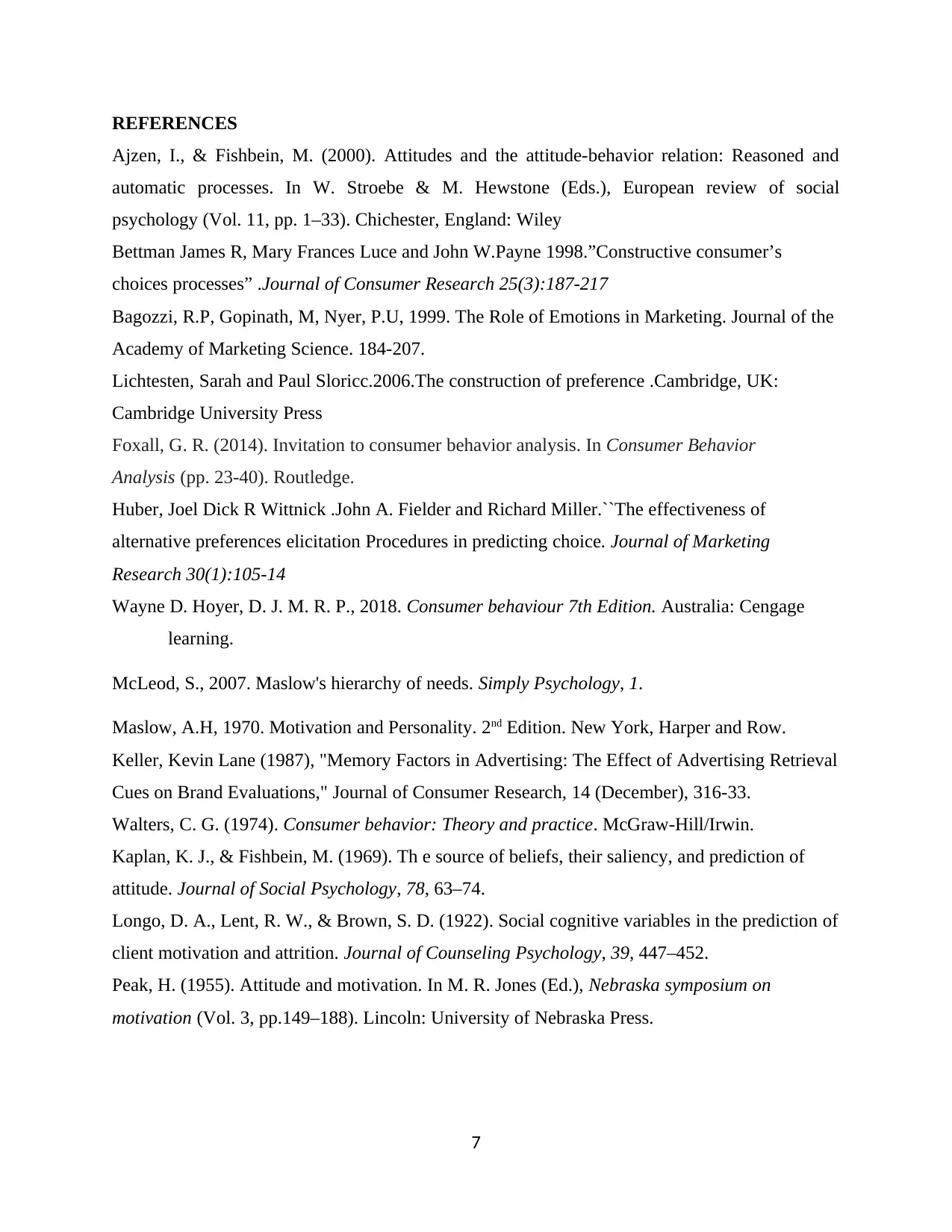
REFERENCES
Ajzen, I., & Fishbein, M. (2000). Attitudes and the attitude-behavior relation: Reasoned and
automatic processes. In W. Stroebe & M. Hewstone (Eds.), European review of social
psychology (Vol. 11, pp. 1–33). Chichester, England: Wiley
Bettman James R, Mary Frances Luce and John W.Payne 1998.”Constructive consumer’s
choices processes” .Journal of Consumer Research 25(3):187-217
Bagozzi, R.P, Gopinath, M, Nyer, P.U, 1999. The Role of Emotions in Marketing. Journal of the
Academy of Marketing Science. 184-207.
Lichtesten, Sarah and Paul Sloricc.2006.The construction of preference .Cambridge, UK:
Cambridge University Press
Foxall, G. R. (2014). Invitation to consumer behavior analysis. In Consumer Behavior
Analysis (pp. 23-40). Routledge.
Huber, Joel Dick R Wittnick .John A. Fielder and Richard Miller.``The effectiveness of
alternative preferences elicitation Procedures in predicting choice. Journal of Marketing
Research 30(1):105-14
Wayne D. Hoyer, D. J. M. R. P., 2018. Consumer behaviour 7th Edition. Australia: Cengage
learning.
McLeod, S., 2007. Maslow's hierarchy of needs. Simply Psychology, 1.
Maslow, A.H, 1970. Motivation and Personality. 2nd Edition. New York, Harper and Row.
Keller, Kevin Lane (1987), "Memory Factors in Advertising: The Effect of Advertising Retrieval
Cues on Brand Evaluations," Journal of Consumer Research, 14 (December), 316-33.
Walters, C. G. (1974). Consumer behavior: Theory and practice. McGraw-Hill/Irwin.
Kaplan, K. J., & Fishbein, M. (1969). Th e source of beliefs, their saliency, and prediction of
attitude. Journal of Social Psychology, 78, 63–74.
Longo, D. A., Lent, R. W., & Brown, S. D. (1922). Social cognitive variables in the prediction of
client motivation and attrition. Journal of Counseling Psychology, 39, 447–452.
Peak, H. (1955). Attitude and motivation. In M. R. Jones (Ed.), Nebraska symposium on
motivation (Vol. 3, pp.149–188). Lincoln: University of Nebraska Press.
7
Ajzen, I., & Fishbein, M. (2000). Attitudes and the attitude-behavior relation: Reasoned and
automatic processes. In W. Stroebe & M. Hewstone (Eds.), European review of social
psychology (Vol. 11, pp. 1–33). Chichester, England: Wiley
Bettman James R, Mary Frances Luce and John W.Payne 1998.”Constructive consumer’s
choices processes” .Journal of Consumer Research 25(3):187-217
Bagozzi, R.P, Gopinath, M, Nyer, P.U, 1999. The Role of Emotions in Marketing. Journal of the
Academy of Marketing Science. 184-207.
Lichtesten, Sarah and Paul Sloricc.2006.The construction of preference .Cambridge, UK:
Cambridge University Press
Foxall, G. R. (2014). Invitation to consumer behavior analysis. In Consumer Behavior
Analysis (pp. 23-40). Routledge.
Huber, Joel Dick R Wittnick .John A. Fielder and Richard Miller.``The effectiveness of
alternative preferences elicitation Procedures in predicting choice. Journal of Marketing
Research 30(1):105-14
Wayne D. Hoyer, D. J. M. R. P., 2018. Consumer behaviour 7th Edition. Australia: Cengage
learning.
McLeod, S., 2007. Maslow's hierarchy of needs. Simply Psychology, 1.
Maslow, A.H, 1970. Motivation and Personality. 2nd Edition. New York, Harper and Row.
Keller, Kevin Lane (1987), "Memory Factors in Advertising: The Effect of Advertising Retrieval
Cues on Brand Evaluations," Journal of Consumer Research, 14 (December), 316-33.
Walters, C. G. (1974). Consumer behavior: Theory and practice. McGraw-Hill/Irwin.
Kaplan, K. J., & Fishbein, M. (1969). Th e source of beliefs, their saliency, and prediction of
attitude. Journal of Social Psychology, 78, 63–74.
Longo, D. A., Lent, R. W., & Brown, S. D. (1922). Social cognitive variables in the prediction of
client motivation and attrition. Journal of Counseling Psychology, 39, 447–452.
Peak, H. (1955). Attitude and motivation. In M. R. Jones (Ed.), Nebraska symposium on
motivation (Vol. 3, pp.149–188). Lincoln: University of Nebraska Press.
7
1 out of 7
Related Documents
Your All-in-One AI-Powered Toolkit for Academic Success.
+13062052269
info@desklib.com
Available 24*7 on WhatsApp / Email
![[object Object]](/_next/static/media/star-bottom.7253800d.svg)
Unlock your academic potential
© 2024 | Zucol Services PVT LTD | All rights reserved.





